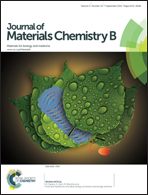Dielectric properties of fluorine substituted hydroxyapatite: the effect of the substitution on configuration of hydroxide ion chains
Abstract
Hydroxyapatite (HAp) [Ca5(PO4)3OH] is an extremely popular biomaterial. Moreover, HAp durability is well-known to be enhanced by fluoridation. We prepared fluoridated HAp (F-HAp; Ca5(PO4)3(OH)1−xFx) ceramics by substituting F− ions for OH− ions of HAp. F-substitution dependence of dielectric properties in F-HAp was measured to detect the configuration change of OH− ion chains. Dielectric relaxation of two kinds was observed. Each kind had a different relaxation time. Faster relaxation, which is associated with the reorientation motion of OH− ions, was only observed at the low F-substitution range (0 ≤ x < 0.35). The relaxation strength decreased as the F-substitution increased. It became zero at x = 0.35, suggesting that F-substitution induces hydrogen bonds. One F− ion substituted for an OH− ion forms two hydrogen bonds with the two neighboring OH− ions and inhibits the motion of OH− ions, which results in some kind of ordered configuration in F-HAp. The configuration might be an origin that enhances the durability of the F-HAp.


 Please wait while we load your content...
Please wait while we load your content...